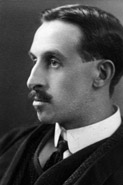Architect Percy Erskine Nobbs
Prolific architect Percy Nobbs made his mark on the McGill campus like few professors before or since. Today, eight buildings on campus designed by him stand as monuments to his vision, as do others in locations as far flung as British Columbia and South Africa. From the Alberta Legislature in Edmonton to McGill's much admired Osler Library, Nobbs's influence on the Canadian architectural landscape is impressive. He was a man of many talents -- and some eccentricities -- and was recognized as an early conservationist working for the protection of Atlantic salmon and, rather amazingly, won a silver medal in fencing at the 1908 Olympics.

Notman Photographic Archives, McCord Museum
Born in Scotland in 1875, Nobbs's early training was under noted Scottish architect Robert Lorimer, and Nobbs quickly distinguished himself, winning prizes and scholarships. Eventually taking up work in England, Nobbs's talents were largely wasted as a draftsman, until his mentors urged him to stop "hacking for architects in London" and recommended him to head the School of Architecture at McGill.
He arrived in Montreal in 1903, and quickly set about changing the McGill campus, arguing with the University administration that architecture needed more than words and pictures to be taught -- real buildings were required, designed, naturally, by himself. The University cautiously agreed, on the condition that he work with another practising architect.
His first commission was a new structure to accommodate the McGill Student Union, the building which is now home to the McCord Museum on Sherbrooke Street. Then, when fire destroyed the Macdonald Engineering Building in 1907, Nobbs was called upon to redesign and rebuild the facility, working with the building's donor and McGill governor, Sir William Macdonald.
Nobbs, who had little patience for administrative duties, resigned as director of the architecture program in 1909, scaling back his responsibilities to concentrate on architectural practice with a partner, George Taylor Hyde. A gifted painter and sculptor, he remained a professor of design at McGill, and was described by architect J. Kenneth Nesbitt as "a genius but irascible."
"At McGill he was more feared than loved," Nesbitt recalls in Edgar Andrew Collard's The McGill You Knew, "but he taught many young men how to practise the profession of architecture successfully."
Nobbs's pedagogic style would likely not sit well in today's more sensitive university environment. "More than once," Nesbitt writes, "I have seen him look at a student's work, mutter 'Christ!' then with both hands tear the drawing from the board, put in a fresh sheet of paper and start drawing furiously in dead silence."
The late John Bland, BArch'33, a longtime director of the school, also recalls an unconventional Nobbs, whose major publications include one book on design, but also one on salmon fishing, and another on fencing tactics. "What other McGill professor85has won an Olympic medal on a summer vacation?" writes Bland in Collard's book, noting as well that "it was his explosive profanity that made his lessons memorable."
At the outbreak of the First World War, Nobbs enlisted in the army -- at age 39 -- and saw service at the front. In the years after the war, he and partner George Hyde designed many buildings in downtown Montreal, including the University Club on Mansfield and the Drummond Medical Building, and at McGill. The Redpath Library extension, the Pulp and Paper Research Institute on University Street, and the Pathological Institute at the corner of Pine Avenue and University Street were all his creations. Throughout his career, Nobbs would work on smaller projects for McGill as well, including the Osler Library and a stained glass tribute in the Redpath Library to members of a McGill fraternity who died in the Great War. He even designed decorations for the royal visits to McGill in 1939 and 1951. In 1957 he was awarded an honorary Doctor of Letters by McGill, and he died in November 1964.
For more on Percy Nobbs see cac.mcgill.ca/nobbs and Percy Erskine Nobbs: Architect, Artist, Craftsman by Susan Wagg (McGill-Queen's Press, 1982).


